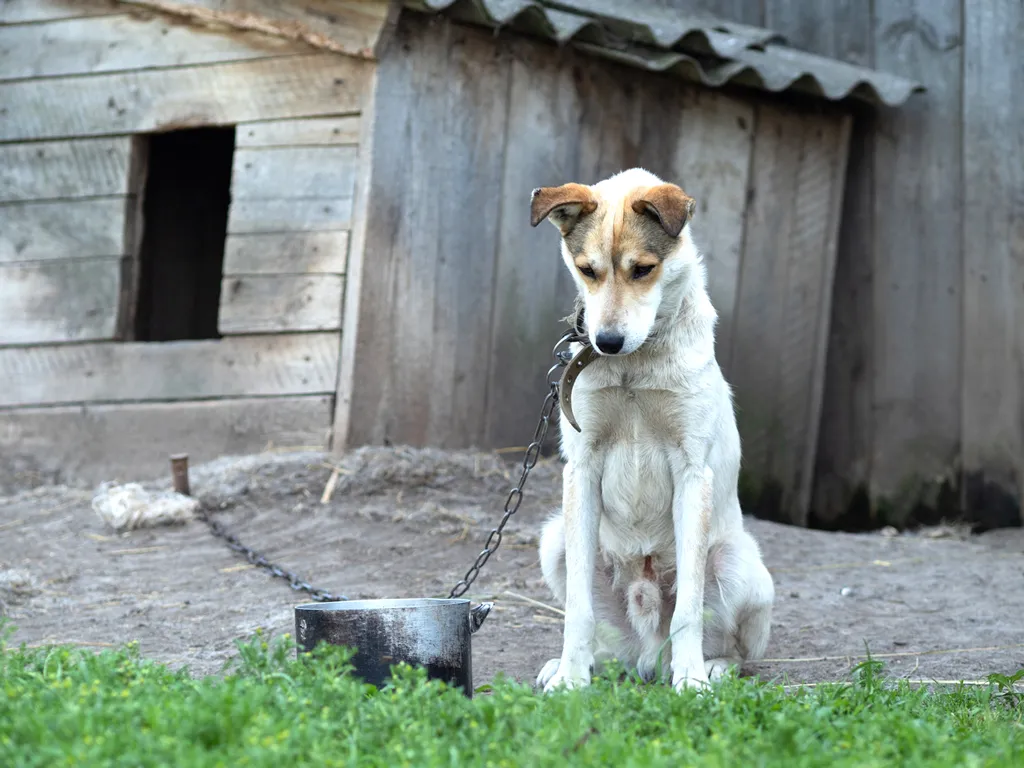Animals, especially our beloved dogs, bring immense joy and companionship into our lives. As pet owners, we have a fundamental responsibility to ensure their well-being. This includes providing them with proper shelter, food, water, and exercise. Unfortunately, the practice of chaining dogs outside raises concerns about their welfare. Let’s delve into the legality and ethical implications of chaining dogs outside in North Carolina, and explore some humane alternatives.
The Issue of Chaining Dogs
Chaining dogs outside restricts their movement and can have a significant negative impact on their physical and mental health. Dogs are social creatures who crave interaction and exploration. Chaining confines them to a limited space, depriving them of opportunities to exercise, play, and engage with their surroundings. Exposure to extreme weather conditions like heat, cold, rain, and sun can also be detrimental.
North Carolina’s Specific Situation
Many states have implemented laws restricting or banning chaining practices altogether. North Carolina, however, is one of the few states without a statewide ban. This means the legality of chaining a dog outside depends on the specific city or county ordinances within the state.
Chaining Laws in North Carolina
No Statewide Ban
North Carolina does not have a law prohibiting the chaining of dogs. This leaves the regulations up to individual municipalities.
Local Ordinances Take Precedent
Cities and counties within North Carolina can establish their own ordinances regarding chaining dogs. These ordinances may:
- Completely ban chaining.
- Permit chaining under specific conditions, such as limitations on tether length, access to proper shelter, and time spent chained.
Examples of Local Ordinances
Raleigh
The city of Raleigh has a tethering ordinance that regulates the unattended restraint of dogs. It prohibits tethering a dog for more than three hours in a 24-hour period [1]. There are also requirements for providing adequate shelter, food, water, and a tether of appropriate length with swivels on both ends [1].
Charlotte
Charlotte’s ordinance allows tethering but outlines specific guidelines. These include a minimum tether length of 10 feet, access to proper shelter, and tethering only during non-threatening weather conditions [2].
Wilmington
Wilmington’s ordinance is similar to Charlotte’s, permitting tethering with limitations on tether length, shelter requirements, and tethering only during favorable weather [3].
How to Find Your Local Ordinance
The specific regulations regarding chaining dogs in your area will depend on your city or county. Here’s how to find the relevant ordinance:
- Visit your city or county government’s website and search for animal control regulations or leash laws.
- Contact your local animal control department directly.
Regulations Around Chaining (Even When Allowed)
Even in areas where chaining is permitted, there are usually regulations in place to ensure some level of animal welfare. These regulations may include:
- Shelter: Dogs chained outside must have access to adequate shelter that protects them from the elements, including extreme heat, cold, rain, and sun.
- Food and Water: A constant supply of clean, fresh water and appropriate food must be readily available.
- Basic Needs: The dog should have sufficient space to move around comfortably, lie down, and stand up.
- Length of Time Chained: There may be limitations on the total amount of time a dog can be chained in a single day.
Addressing Concerns About Chaining
Proponents of chaining sometimes argue that it allows dogs to be outside and provides security for their property. However, these concerns can be addressed in more humane ways. Securely fenced-in yards allow dogs to enjoy the outdoors safely, while proper training and socialization can deter unwanted behavior.
Alternatives to Chaining
There are several humane alternatives to chaining a dog outside:
- Secure Fenced-In Yards: Constructing a secure fence around your property creates a safe space for your dog to roam freely and enjoy the outdoors. This allows them to exercise, explore, and relieve themselves without restraint. Fences should be tall enough to prevent jumping and made of sturdy materials to ensure your dog’s safety and prevent escape.
- Tethering Done Responsibly: If tethering is absolutely necessary, it should only be done under strict supervision and for short periods. Here’s how to tether responsibly:
- Tether Length: Use a tether that allows the dog ample space to move around comfortably, including the ability to lie down, stand up, and turn around freely. The tether should never be a strangulation hazard.
- Swivel Tethers: Utilize a tether with swivels on both ends to prevent tangling and choking.
- Comfortable Tether Material: Choose a tether made from a comfortable material that won’t rub or irritate the dog’s skin.
- Supervision: Never leave a tethered dog unattended for extended periods.
- Indoor Housing: Whenever possible, dogs are best kept indoors as part of the family. This provides them with companionship, warmth, and a sense of security. If you can’t have your dog indoors all the time, create a climate-controlled space like a dog run or crate to ensure their comfort during extreme weather conditions.
Reporting Animal Neglect
If you witness a dog being chained outside in violation of local ordinances, or suspect neglect based on inadequate shelter, food, water, or overall condition, it’s important to report it.
Recognizing Signs of Neglect
Here are some signs that a chained dog might be neglected:
* Lack of adequate shelter, food, or water
* Tether that is too short, tangled, or made of an uncomfortable material
* Signs of malnourishment or dehydration
* Untreated wounds or illnesses
* Excessive vocalization or pacing due to stress or anxiety
How to Report an Animal Concern
- Contact your local animal control department: This is the most direct route to report suspected animal neglect. They will investigate the situation and take appropriate action.
- Animal welfare organizations: Organizations like the ASPCA or local humane societies may also be able to offer assistance or advice on reporting neglect.
Conclusion
As pet owners, we have a responsibility to ensure the well-being of our furry companions. Chaining dogs outside raises significant concerns about their physical and mental health. While North Carolina lacks a statewide ban, many cities and counties have ordinances regulating chaining practices.
There are several humane alternatives available, such as secure fenced-in yards, responsible tethering for short periods, and indoor housing whenever possible. If you witness a dog being chained in violation of local ordinances or suspect neglect, don’t hesitate to report it to animal control. By promoting responsible pet ownership and advocating for animal welfare, we can create a safer and happier environment for all dogs.
Additional Resources
- American Society for the Prevention of Cruelty to Animals (ASPCA): https://www.aspca.org/
- The Humane Society of the United States: https://www.humanesociety.org/
- National Sheriffs’ Association (NSA) Center for Animal Cruelty Prevention: https://www.sheriffs.org/government-affairs/resolutions
Remember: This blog post is intended for informational purposes only and should not be taken as a substitute for professional advice. Always consult your veterinarian or local animal control department for guidance on specific situations.



